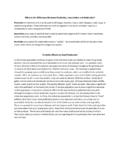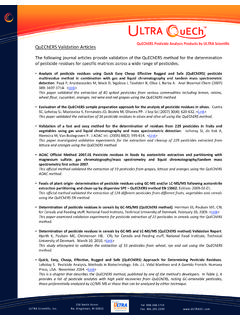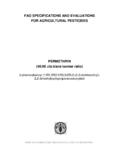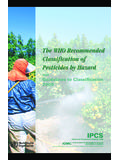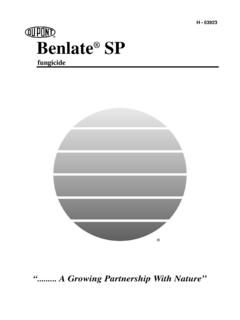Transcription of Pesticides - Health and Safety Executive
1 Code of practice for using plantprotection productsThis code of practice has been prepared jointly by the Department for Environment,Food and Rural Affairs (Defra), the Health and Safety Commission (HSC) and theNational Assembly for Wales Environment, Planning and Countryside for Environment, Food and Rural AffairsNobel House17 Smith SquareLondon SW1P 3 JRTelephone 020 7238 6000 Website: Crown copyright 2006 The text in this document (excluding the Royal Arms and departmental logos) may be reproduced free ofcharge in any format or medium provided that it is reproduced accurately and not used in a misleadingcontext. The material must be acknowledged as Crown copyright and the title of the document enquiries relating to the copyright in this document should be addressed toThe Information Policy Team, Office of Public Sector Information, St Clements House, 2-16 Colegate, Norwich, NR3 : 01603 723000 or e-mail: copies of this publication are available from:Defra PublicationsAdmail 6000 LondonSW1A 2 XXTel: 08459 556000 This document is also available on the Defra websitePublished by the Department for Environment, Food and Rural Affairs.
2 Printed in the UK, January 2006, onmaterial that contains 100% recycled fibre for uncoated paper and a minimum of 75% recycled fibre forcoated code PB 11090 This code is also available on the PSD website( #Codes_of_Practice)and on the Defra website ( ) A Welsh language version of this code is available on the NAW website ( ).Printed copies of the Welsh language version are available from:Plant Health and Biotechnology BranchBiotechnoleg a Iechyd PhlanhigionAnimal and Plant Health DivisionIs-Adran Polisi Iechyd Anifeiliaid a PhlanhigionWelsh Assembly GovernmentLlywodraeth Cynulliad CymruDepartment for Environment, Planning and Adran yr Amgylchedd, Cynllunio a Countryside Chefn GwladCathays Park Parc CathaysCardiff CF10 3 NQCaerdydd CF10 3 NQAs a Scottish version of this code (approved by the Scottish Parliament) is being produced, this code is forEngland and Wales only.
3 The Scottish version of the code will be available on the Scottish Executive copies of the Scottish version will be available from: APPPS cottish Executive Environment and Rural Affairs DepartmentPentland House, 47 Robb s LoanEdinburgh EH14 : 0131 244 6356E-mail: Northern Ireland will produce their own updated version of this code in due of practice for using plantprotectionproductsJanuary 2006 Part AEmergency procedures8A1 Action plans8A2 Personal contamination8A3 Dealing with spillage9A4 Suspected animal poisoning10A5 Fire10 Part BForeword11 Part CNotices12C1 General notice under both the Food and Environment Protection Act 1985and Health and Safety at Work etc Act 197412C2 Notice of issuing this code under section 17 of the Food and Environment Protection Act 198512C3 Notice of this code being approved by the Health and Safety Commissionunder section 16 of the Health and Safety at Work etc Act 197413C4 Notice of this code being approved under regulation 21 of theGroundwater Regulations 199814 Section How do I decide if it is necessary to use a pesticide?
4 What advice is given in this code? What does this code cover? is the legal status of this code? Who should read this code? What other advice is available? terms18 Section 2 Training and Who must be trained in using Pesticides ? training do I need? When would I need a certificate of competence? can I use Pesticides without a certificate of competence? Where do I get certificates of competence? What training and certificates are needed for salespeople, advisers,managers and people who draft contracts? Continuing professional development (CPD)26 Section 3 Planning and the risk of using Pesticides as low as Considering whether to use a to do if you decide that you need to use a the right The product Other Checking the The seeds, cuttings and so Applying a pre-prepared Storing How should I store Pesticides ? What extra conditions apply to mobile stores? Moving Pesticides into and out of the Do not leave pesticide containers The COSHH When do COSHH regulations apply?
5 When is an assessment suitable and sufficient? Finding out about the Assessing the risks, who might be harmed and how? what needs to be done to control Recording the Reviewing the Preventing people being exposed to Pesticides at How can exposure be prevented or adequately controlled? Measures for preventing exposure to Measures for controlling exposure to personal protective equipment (PPE) Suitable personal protection Maintaining control Welfare What you need to Monitoring exposure and Health When is it necessary to monitor exposure to Pesticides ? What is Health surveillance? When is Health surveillance necessary? else do employers need to do? What about sudden illness? the Neighbouring must notice be given? Giving notice to bystanders and occupiers of neighbouring Public rights of Who should I tell if there is an incident involving Pesticides ? Further Protecting wildlife and the possible negative can wildlife and plants be protected?
6 Specially designated How can wild birds and mammals be protected? How can bees be protected? Other beneficial and other aquatic Wildlife incident investigation scheme (WIIS) Preventing Pesticides from contaminating surface water and Controlling weeds in or near Applying Pesticides from an Invasive weeds69 Section 4 Working with Preparing to apply Checks to carry Dangerous Handling pesticide The General precautions when transporting Pesticides inside a Loading and unloading Further Filling should I fill the equipment used to apply Pesticides ? precautions should I take when filling equipment? Methods of applying a How you should apply the pesticide to the area to be Which application methods need special precautions? reduced-volume , mists and smokes in enclosed Dusts, granules, pellets and vehicles without Paved areas and public Using hand-held Seed and drenching Weed control in or near Applying Pesticides from an Spray The effects of spray What causes spray drift?
7 How can off-target drift be prevented or controlled? working with you need to do after you have applied a pesticide92 Contents6 ContentsSection 5 Disposing of pesticide Change to the law for farmers and How to reduce the amount of waste you How to dispose of unwanted pesticide concentrates and ready to How to dispose of dilute pesticide How to dispose of waste pesticide How to dispose of other pesticide waste Where you can get more information100 Section 6 Keeping Storage Records of pesticide COSHH assessment Records of environmental risk Records of monitoring Maintenance records of exposure control Health surveillance Disposal records106 Annex A Laws referred to in this code109 Annex BBibliography119 Annex C Glossary of terms used in this code126 Glossary 1 This glossary defines words used in this code126 Glossary 2 The definitions in glossary 2 relate to equipment and methods of applying Pesticides .
8 They are loosely based on the NPTC assessmentschedules for certificates of competence in using Pesticides safely131 Annex D Addresses134 Annex E Guidance on using personal protective equipment138 Annex F Record sheet for pesticide treatments142 Annex GApplying Pesticides from an aircraft144 Annex HThings to consider when preparing and managing contracts for applyingpesticides in amenity areas146 Annex I Things to consider when using Pesticides in high-security or high-riskamenity and industrial areas152 Index154 Contributors of photographs1677 ContentsList of tables and decision treesTable 1 This code covers everything listed below16 17 Table 2 Subjects you need to know about (training)20 21 Flow chart 1Is a certificate needed for the product I plan to use?22 Flow chart 2Do I need a certificate?23 Table 3 Measures for protecting bees62 Table 4 Options for dealing with drainage and run-off from dedicated mixing andloading areas66 Table 5 Action when filling equipment76 78 Table 6A guide to wind speed and the use of field crop sprayers with conventional nozzles90 Table 7 Summary of records to be kept107 1088 Emergency proceduresA1 Action plansAnyone who uses Pesticides professionally (that is, as part of their job) must be trained inemergency procedures and must have, and understand, their own action plans.
9 These emergencyaction plans should be kept up to date to cover new equipment or new ways of working. Manyproduct labels will have specific advice on what to do if you are contaminated or there is aspillage or fire. This information is always on the manufacturer s material Safety data sheet(MSDS), which you can get when you buy the product. A2 Personal contaminationYou can be exposed to Pesticides through your skin (usually the main route of exposure) andeyes, by breathing them in or by swallowing them. Your emergency action plan should considerhow to protect the environment when you are dealing with any exposure or you, or people you are working with or nearby, feel unwell when you are using Pesticides , orafter you have used them, you should do the following: Stop work and, if necessary, call for medical help immediately. Prevent further exposure. Use appropriate personal protective equipment when helping acontaminated person or handling contaminated surfaces. Move the casualty away from the source of contamination and remove all theircontaminated clothing.
10 Wash contaminated skin or hair thoroughly with plenty of clean water. If eyes are contaminated, immediately flush them with plenty of clean running water. Thencover the eye with a sterile eye pad or similar lint-free dressing. If someone has swallowed a pesticide, do not try to make them vomit (be sick) unless theproduct label recommends this. Make the casualty rest and keep them warm. If the casualty is unconscious, check their breathing and pulse and put them in therecovery position. If there are no signs of breathing or a pulse, begin CPR(cardiopulmonary resuscitation), if necessary, using a method of artificial respiration whichwill avoid the risk of you swallowing or breathing in the pesticide. Give the doctor or hospital a copy of the product labels and material Safety data this is not possible, give them details of the active ingredients and the product names. Make sure you or someone else reports the incident to your nearest Health and SafetyExecutive (HSE) office.










